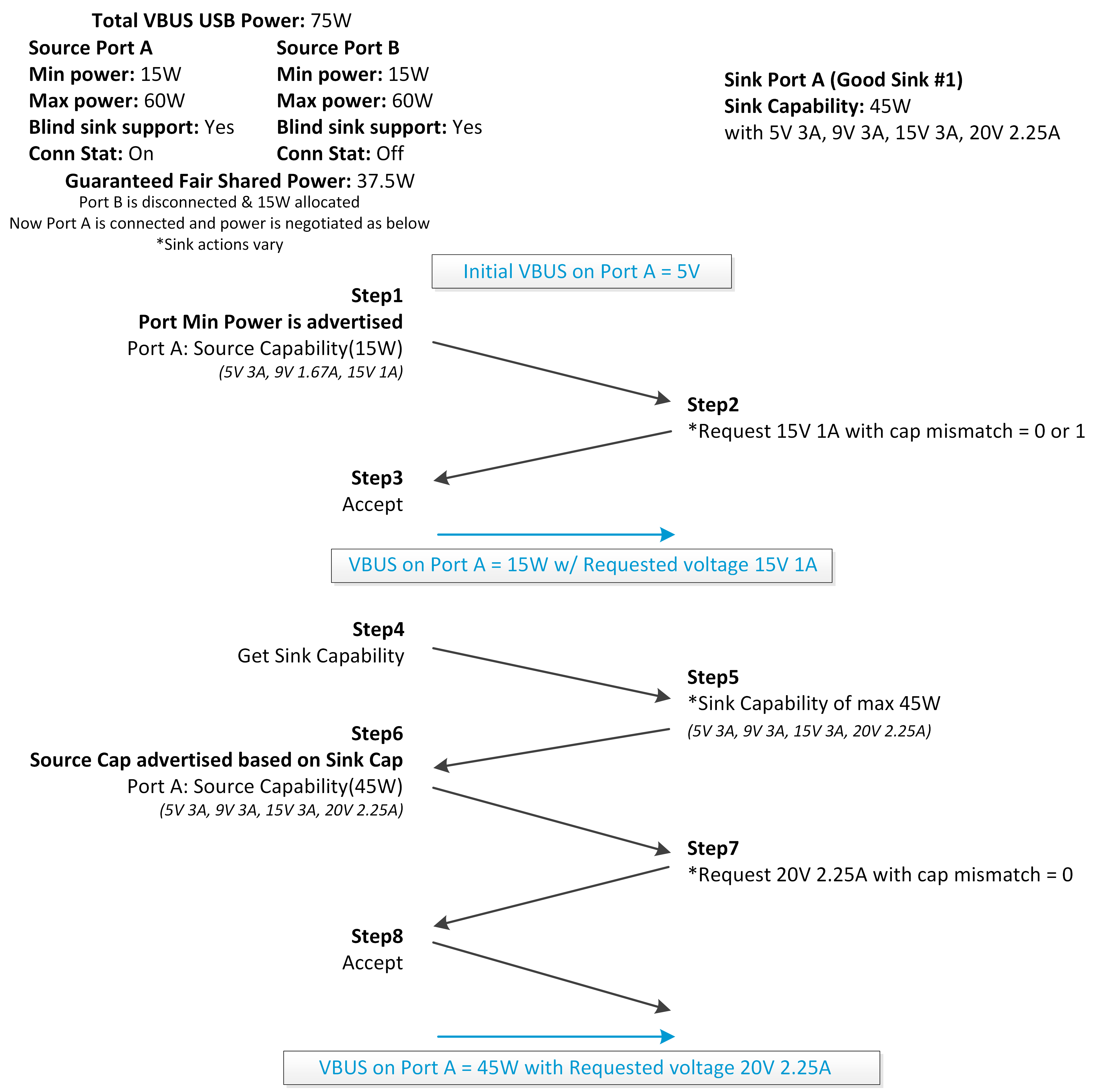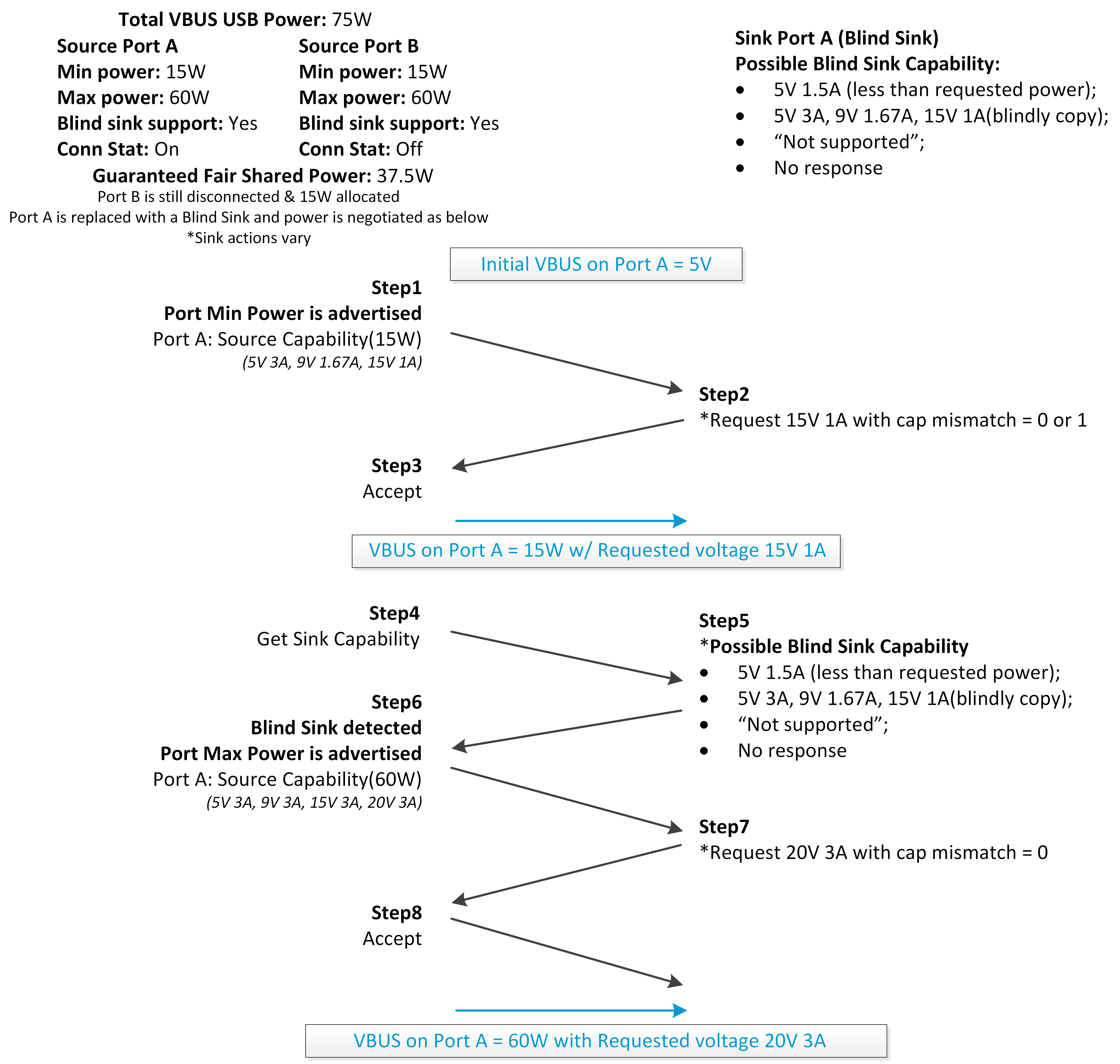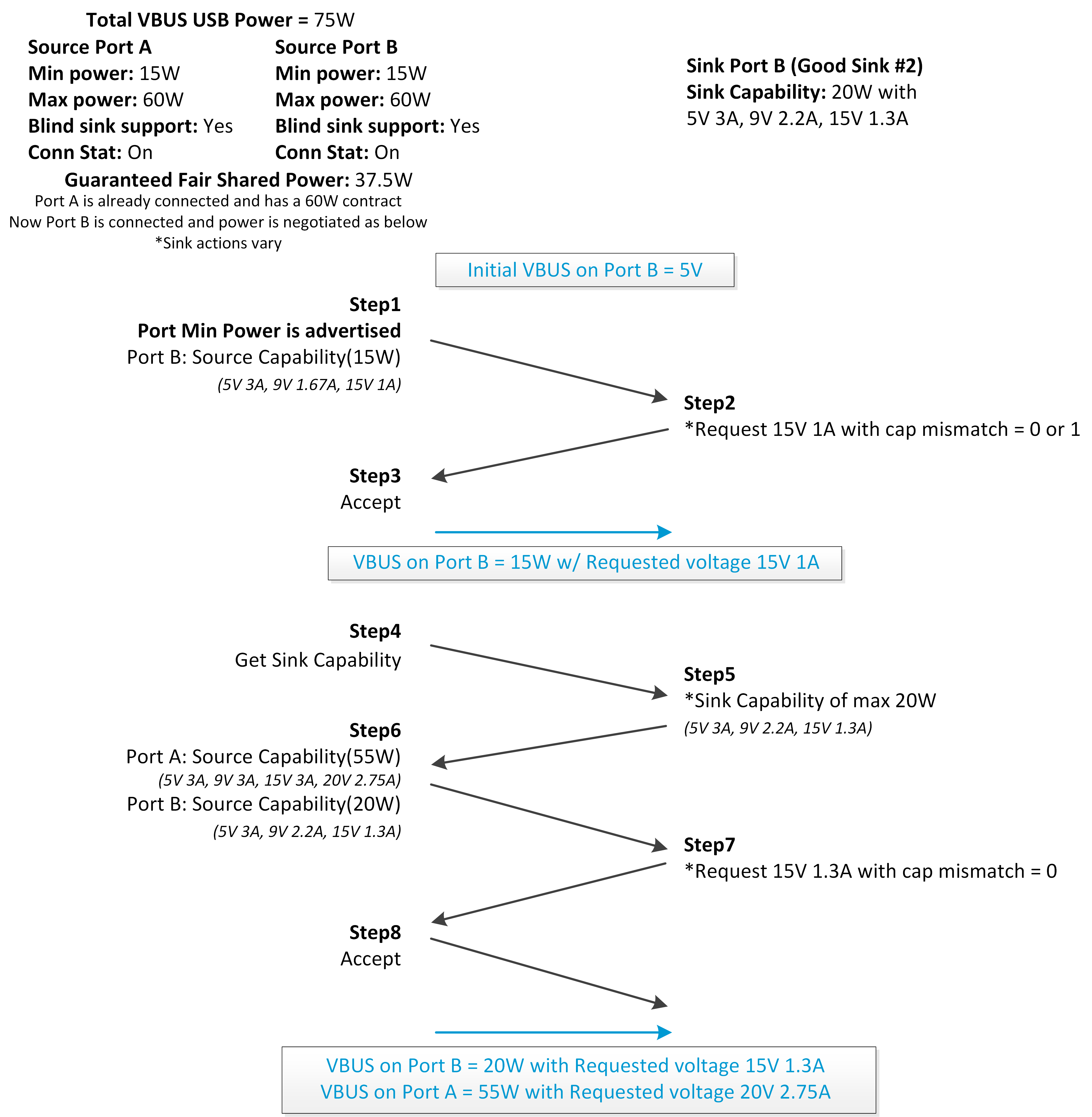SLVAFG6B December 2022 – November 2024 TPS25762-Q1 , TPS25763-Q1 , TPS25772-Q1
5.2.1 FSP Policy Example – Blind Sink Support
This section provides examples of Fair Share Power Policy's power distribution with Blind Sink Support enabled for both ports and in the event of a port connecting to a Sink that fails to return Sink Capabilities correctly. Note that the Max Power option is not enabled in these examples. Table 5-6 shows the SPM Engine parameters used in this section's example. The FSP Parameters shown in Table 5-7 are used in the Fair Share Power Policy's power distribution to achieve FSP between two Sinks.
| SPM Engine Parameters | Configuration | Description |
|---|---|---|
| System Max Power | 75W | Total system power capacity allocated for Port A and B |
| Port A Max Power | 60W | Maximum Port A Power |
| Port B Max Power | 60W | Maximum Port B Power |
| Port A Min Power | 15W | Minimum Port A power |
| Port B Min Power | 15W | Minimum Port B power |
| Shared Mode | FSP with Blind Sink Support | Port Max Power is offered to Blind Sinks |
| Fair Share Power Policy Parameter | Value | Description |
|---|---|---|
| Equally Divided Shared Power | (75-(15+15))/2=22.5W | Shared power for each port that can be distributed if available: (Total VBUS power – Sum of Port A and B's Min Power)/Total number of ports |
| Per Port Guaranteed FSP | 15+22.5W=37.5W | Port Min Power + Per Port Equally Divided Shared Power = Per Port Guaranteed FSP |
Three example scenarios of Fair Share Power Policy operation (when Blind Sink Support is enabled) are shown in Table 5-8. The table format in this section is structured differently to show how Blind Sinks are handled and supported by the SPM.
| Port A | Port B | SPM Operation Description | |
|---|---|---|---|
| Initially Allocated | 15W | 15 W | Min Power is initially allocated for Port A and Port B. |
| Scenario 1: Port A connects to Good Sink #1. Port B is unconnected. | |||
| Source Cap 1 | 15W | The first Source Cap is sent to Port A's Sink with Port Min Power. | |
| Sink Request | 15W | Grant 15W to Port A. | |
| Sink Cap | 45W | Source sends Get Sink Cap message to Port A and max 45W Sink Cap is returned. | |
| Source Cap 2 | 45W | A 45W Source Cap is sent again based on Sink Cap. | |
| Sink Request | 45W | Port A Sink requests 45W. | |
| Power Distributed to Sink | 45W | 45W distributed to Port A Sink. | |
| Scenario 2: Port A is replaced with a Blind Sink. Port B is still unconnected. | |||
| Source Cap 1 | 15W | The first Source Cap is sent to Port A's Sink with Port Min Power. | |
| Sink Request | 15W | Grant 15W to Port A. | |
| Sink Cap | 15W | Source sends Get Sink Cap message to Port A. Source Cap = Sink Cap is returned. Port A Sink is identified as a Blind Sink. | |
| Source Cap 2 | 60W | A Source Cap is sent again with Port Max Power. | |
| Sink Request | 60W | Port A Sink requests 60W. | |
| Power Distributed to Sink | 60W | 60W is distributed to Port A Sink. | |
| Scenario 3: Port B connects to Good Sink #2. Port A continues to deliver 60 W to Blind Sink. | |||
| Source Cap 1 | 15W | The first Source Cap is sent to Port B's Sink with Port Min Power. | |
| Sink Request | 15W | Grant 15W to Port B. | |
| Sink Cap | 20W | Source sends Get Sink Cap message to Port B and max 20W Sink Cap is returned. | |
| Source Cap 2 | 55W | 20W | Port A Sink's required power is less than the Per Port Guaranteed FSP. Port B's required power is higher. The SPM distributes power to the Port A's Sink requesting lower power and the remaining power to Port B's Sink. |
| Sink Request | 55W | 20W | Port A Sink requests 55W and Port B Sink requests 20W. |
| Power Distributed to Sinks | 55W | 20W | 55W distributed to Port A Sink. 20W distributed to Port B Sink. |
Figure 5-5, Figure 5-6, and Figure 5-7 show the PD negotiation flow of the FSP examples from Scenario 1, Scenario 2, and Scenario 3 of Table 5-8, respectively.
 Figure 5-5 FSP Negotiation Flow With
Blind Sink Support – Scenario 1
Figure 5-5 FSP Negotiation Flow With
Blind Sink Support – Scenario 1 Figure 5-6 FSP Negotiation Flow With
Blind Sink Support – Scenario 2
Figure 5-6 FSP Negotiation Flow With
Blind Sink Support – Scenario 2 Figure 5-7 FSP Negotiation Flow With
Blind Sink Support – Scenario 3
Figure 5-7 FSP Negotiation Flow With
Blind Sink Support – Scenario 3